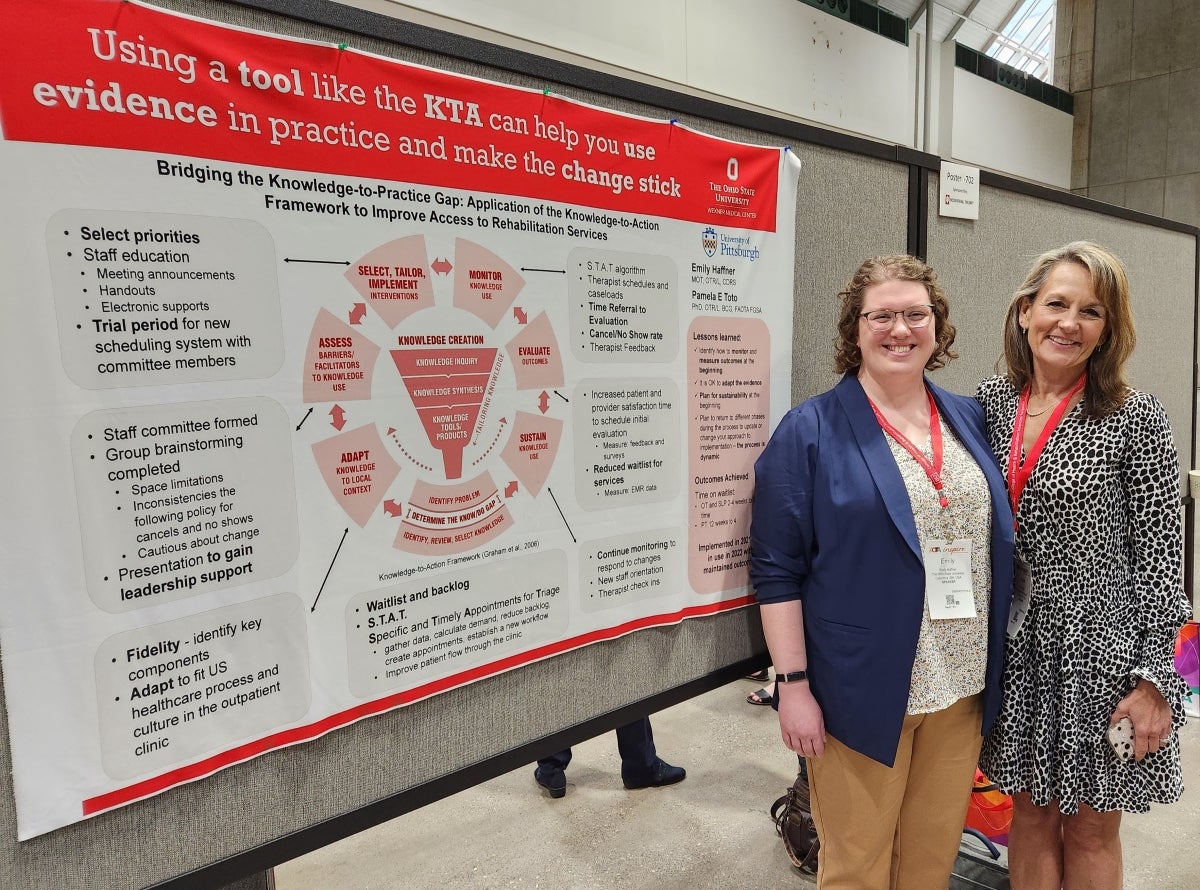The Importance of Evidence-Based Practice
Occupational therapists (OTs) intuitively incorporate evidence-based practices into their work when they draw from past experiences and clinical expertise. However, evidence-based practice (EBP) in occupational therapy involves more than just applying evidence from one’s own practice to one’s own practice. EBP includes a comprehensive system of continuing education and methodical study of clinical research designed to help OTs stay abreast of the latest innovations and methodologies in the field.
The benefits of evidence-based practice in occupational therapy cannot be overstated. When OTs base their clinical decision-making on the latest research in addition to their own expertise, costs go down, efficiency increases, and most importantly, patient outcomes improve. Why? Consider that even the busiest practitioner can see only a limited number of patients with a given condition. A researcher studying the effects of specific treatments on that condition, on the other hand, may have access to data generated by hundreds or even thousands of patients, and their research can drive the development and adoption of therapies that are more effective and less expensive.
EBP has broad support among professional health organizations, insurers, health care administrators and OTs. According to one study, a staggering 97% of OTs agree that EBP is “necessary to practice,” while 92% say it “helps in decision making.” A similar survey of Swedish occupational therapists found that 95% acknowledged the benefit of research-based practice guidelines and an even greater number (99%) conceded that “guidelines are important so that patients receive equal treatment.”
While some notable barriers to EBP implementation in OT settings persist, there are resources available to help OTs overcome them. For example, the University of Pittsburgh School of Health and Rehabilitation Sciences’ 100% online Doctor of Clinical Science in Occupational Therapy (CScD in OT) empowers practitioners with the knowledge and skills they need to find evidence, evaluate evidence, implement evidence in practice, and transform both clients’ lives and the profession of occupational therapy.
Examples of Evidence-Based Practice in Occupational Therapy
Occupational therapy is a science-driven profession and over time, proven standards of care have emerged. For example, there is ample evidence that:
- Sensory, motor and oral interventions can reduce the length of hospital stays in infancy
- Early intervention programs for preterm infants can improve cognitive outcomes through preschool
- Pediatric play-based activities involving modeling and prompting can improve social behavior in early childhood
- Sensory integration can address maladaptive behaviors in older children with sensory processing issues
- Occupational therapy can reduce disease severity in patients with MS
- Cognitive skills training can improve job retention among adults with serious mental illness
- Working with an OT helps older adults stay cognitively healthy and occupationally functional longer
In clinical practice, OTs can draw upon occupational therapy interventions backed by research and adapt them to align with each patient’s skills, condition, activity demands, needs, and wishes. They can also contribute to future evidence-driven changes to the field by collecting and sharing information about their work with researchers and other practitioners.

Common Barriers to Implementing EBP in Occupational Therapy
OTs who want to implement evidence-based practices in their work must overcome:
- Time Constraints – Occupational therapists asked to identify the greatest obstacle to using EBP cited a lack of time to find, read vet, and determine how best to implement research. This is unsurprising, given that most OTs spend a great deal of their time working with clients and developing care plans.
- Inaccessible Resources – OTs also report that the resources necessary for evidence-based practice in occupational therapy can be difficult to find. This is especially true in workplaces that don’t have resource libraries or established continuing education programs.
- Lack of Support – OTs are more likely to seek and follow evidence-based research when encouraged to do so in their work environment. An AJOT report on facilitating EBP implementation encourages organizations to provide OTs with workday access to time and research resources, including computer and literature databases. It also recommends incentives—including professional association membership and journal subscription reimbursements and mentoring programs—to promote broader usage of evidence-based practice in occupational therapy.
- Lack of Confidence – Understanding how to thoughtfully find and use research is a skill like any other, but not one all OTs learn as they train to become occupational therapists. Practitioners need not only access to resources but also a thorough understanding of how to apply their discoveries in the work they do with patients.
- Limited Evidence – Occupational therapy research is an active field but one that is still relatively new research evidence for many interventions is still evolving.
- Lack of EBP Training – Occupational therapy’s emphasis on EBP training is also a relatively recent development. Some OTs were first licensed when client-centered practice strategies (in which client objectives and preferences take precedence over process- and evidence-based therapies) and occupation-based therapy (in which patient engagement in real-life occupations such as eating, dressing, and playing take precedence over formal exercises) were standard.
Fortunately, a solution to overcome many barriers to EBP implementation in occupational therapy is education.

How the University of Pittsburgh’s CScD in Occupational Therapy Program Promotes EBP
Pitt’s post-professional Doctor of Clinical Science (CScD) in Occupational Therapy program is focused on implementing evidence-based practice. The program prepares advanced practitioners to lead the field in evidence-based occupational therapy, education, advocacy and system change with a core clinical occupational therapy doctorate curriculum that includes the following classes:
- Advanced Assessment
- Advocacy for Implementation
- Capstone Phase I
- Capstone Phase II
- Conceptualizing and Assessing Quality Improvement
- Evidence Analysis and Synthesis
- Evidence-Based Protocols and Practice Guidelines
- Evidence Interpretation for Implementation
- Foundations in Implementation
- Implementation Evidence
- The Business of Implementation
- Theories of Change
Students who complete the CScD in OT degree program earn both a highly respected post-professional clinical occupational therapy doctorate conferred by a program internationally recognized for the quality of its academics and research plus the Advanced Practice Certificate in Implementation of Evidence in Clinical Practice. This credential is the only one of its kind in occupational therapy, confirming that students have the skills and tools to find and incorporate evidence into real-world practice at the individual and system levels. For those students who already have a post-professional degree, Pitt offers the opportunity to earn the 12-credit Advanced Practice Certificate on a standalone basis.
EBP is the future of occupational therapy for numerous reasons. EBP:
- Makes OT clinical decisions more transparent, reinforcing practitioner accountability
- Promotes lifelong learning
- Increases communication among clinicians
- Provides more precise rationales for services, facilitating insurance reimbursement
- Results in time savings, cost savings, and improved patient outcomes
Apply to earn your CScD in OT from the University of Pittsburgh today. In just over two years, you will have what it takes to change occupational therapy for the better, using strategies proven to help patients thrive.

